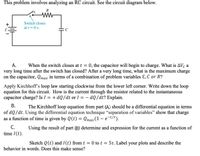Question
thumb_up100%

Transcribed Image Text:This problem involves analyzing an RC circuit. See the circuit diagram below.
Switch closes
at t = 0 s.
А.
When the switch closes at t = 0, the capacitor will begin to charge. What is AVc a
very long time after the switch has closed? After a very long time, what is the maximum charge
on the capacitor, Qmax in terms of a combination of problem variables Ɛ, C or R?
%3D
Apply Kirchhoff's loop law starting clockwise from the lower left corner. Write down the loop
equation for this circuit. How is the current through the resistor related to the instantaneous
capacitor charge? Is I = + dQ/dt or I = – dQ/dt? Explain.
|
В.
The Kirchhoff loop equation from part (A) should be a differential equation in terms
of dQ/dt. Using the differential equation technique “separation of variables" show that charge
as a function of time is given by Q(t) = Qmax(1 – e-t/t).
С.
Using the result of part (B) determine and expression for the current as a function of
time 1(t).
Sketch Q (t) and I(t) from t = 0 to t = 5t. Label your plots and describe the
behavior in words. Does this make sense?
Expert Solution
This question has been solved!
Explore an expertly crafted, step-by-step solution for a thorough understanding of key concepts.
This is a popular solution
Trending nowThis is a popular solution!
Step by stepSolved in 5 steps with 2 images

Knowledge Booster
Similar questions
- In your lab experiment, you observed that the discharging capacitor would exhibit____. a. the same polarity than it was charged at b. the opposite polarity than it was charged atarrow_forwardFind the capacitance ( in units of pF) of a metallic sphere that has a radius of 16.9 cm immersed (ojgao) in a very large oil container with (K =2.16). use Eo = 8.8542x10-12 F.m-1. Metallic sphere Oil Select one: O A. 40.62 O B. 686.42 OC. 10.15 OD. 12.93 O E. 23.72 9:08 Parrow_forwardhow do i answer the attached physics question?arrow_forward
- A student reaches to open a door and gets a small electric shock. She knows that the shock is caused by static electricity, but it seems like in the winter she gets shocked more than in the summer. The student asks her science teacher if there are times of the year when there is more static electricity that builds up than other times of the year. The teacher replies that there is, and it depends on the humidity, or moisture in the air. The more humid the air is, the less static will build up and, therefore, the less you get shocked. Explain why static electricity does not build up as much when the air is humid. In your response, be sure to include: an explanation of static electricity is formed. an explanation of why the student felt a shock when reaching for the door handle. an explanation of how moisture in the air allows static electricity to dissipate. Be sure to consider the completeness of your response, supporting details, and accurate use of terms.arrow_forward.arrow_forwardSolve the problem in Image thank uarrow_forward
- Can you solve the question below?arrow_forwardHybrid vehicles are powered by a gasoline engine paired with an electric motor and batteries. Hybrids get much better mileage in the stop and go of city driving than conventional vehicles do. When you brake to a stop in a conventional car, friction converts the kinetic energy of the car’s motion into thermal energy in the brakes. In a typical hybrid car, depressing the brake pedal will connect a generator that converts much of the car’s kinetic energyinto chemical energy in a battery. Explain how this makes a hybrid vehicle more efficient.arrow_forward
arrow_back_ios
arrow_forward_ios